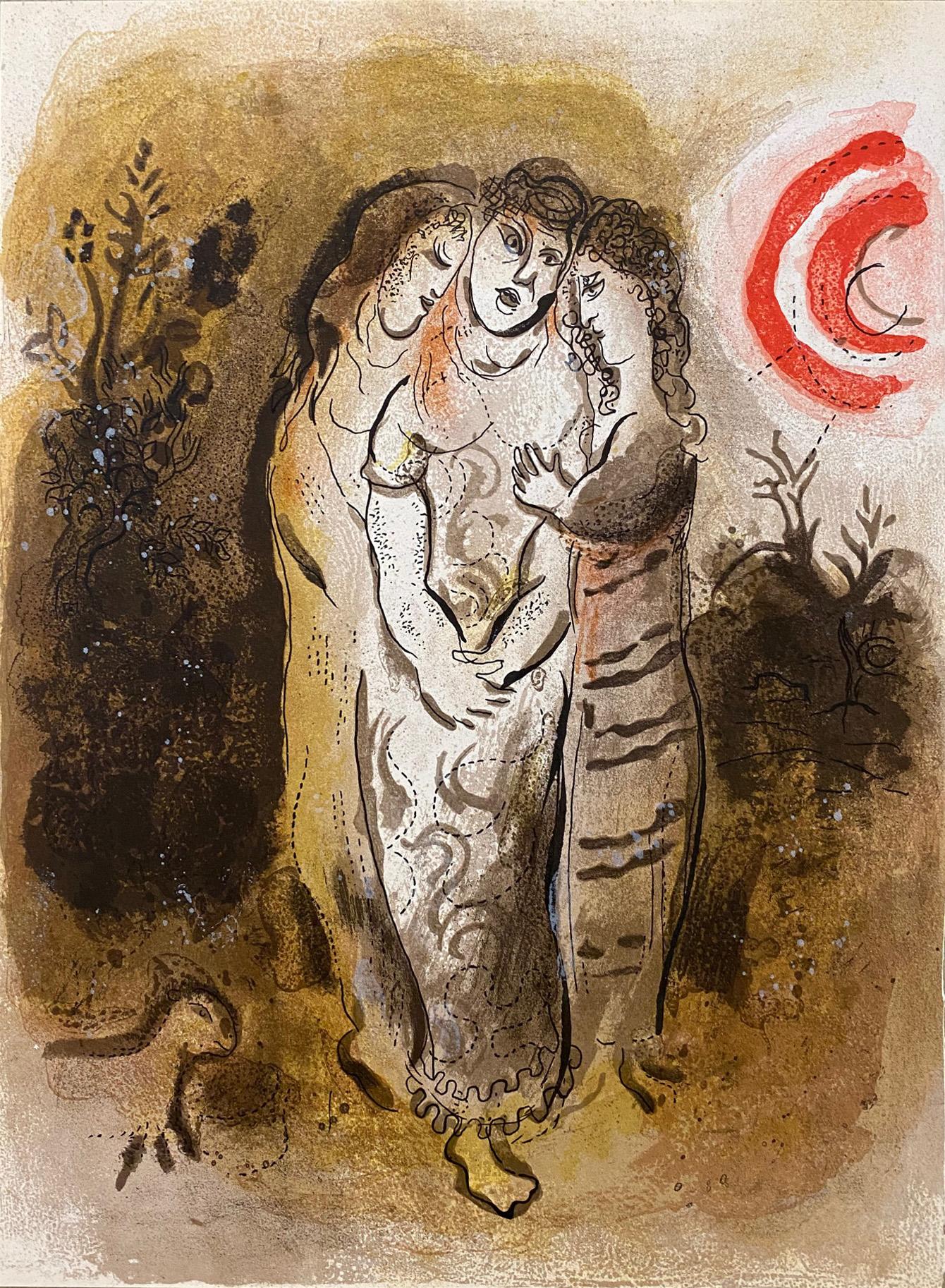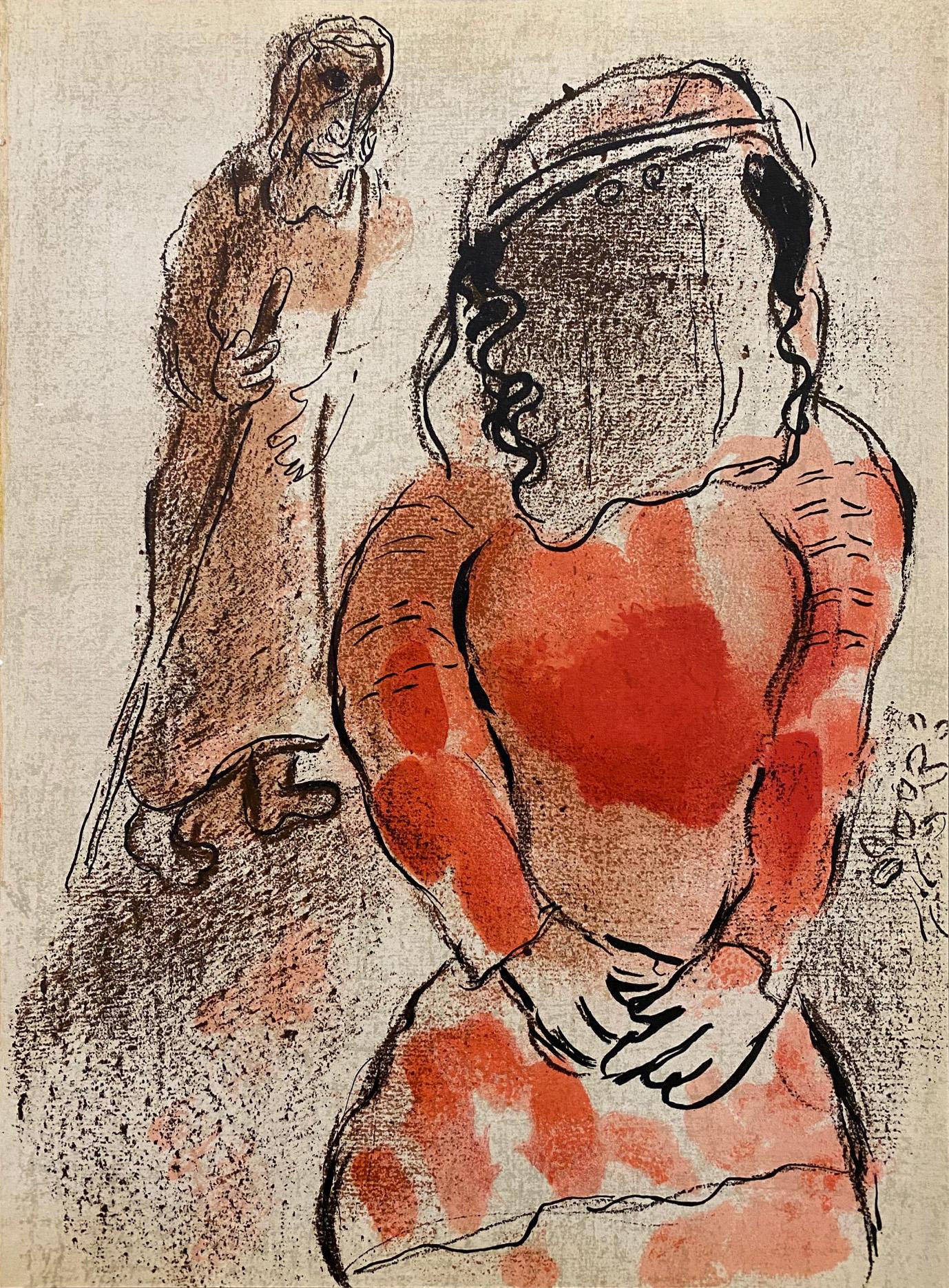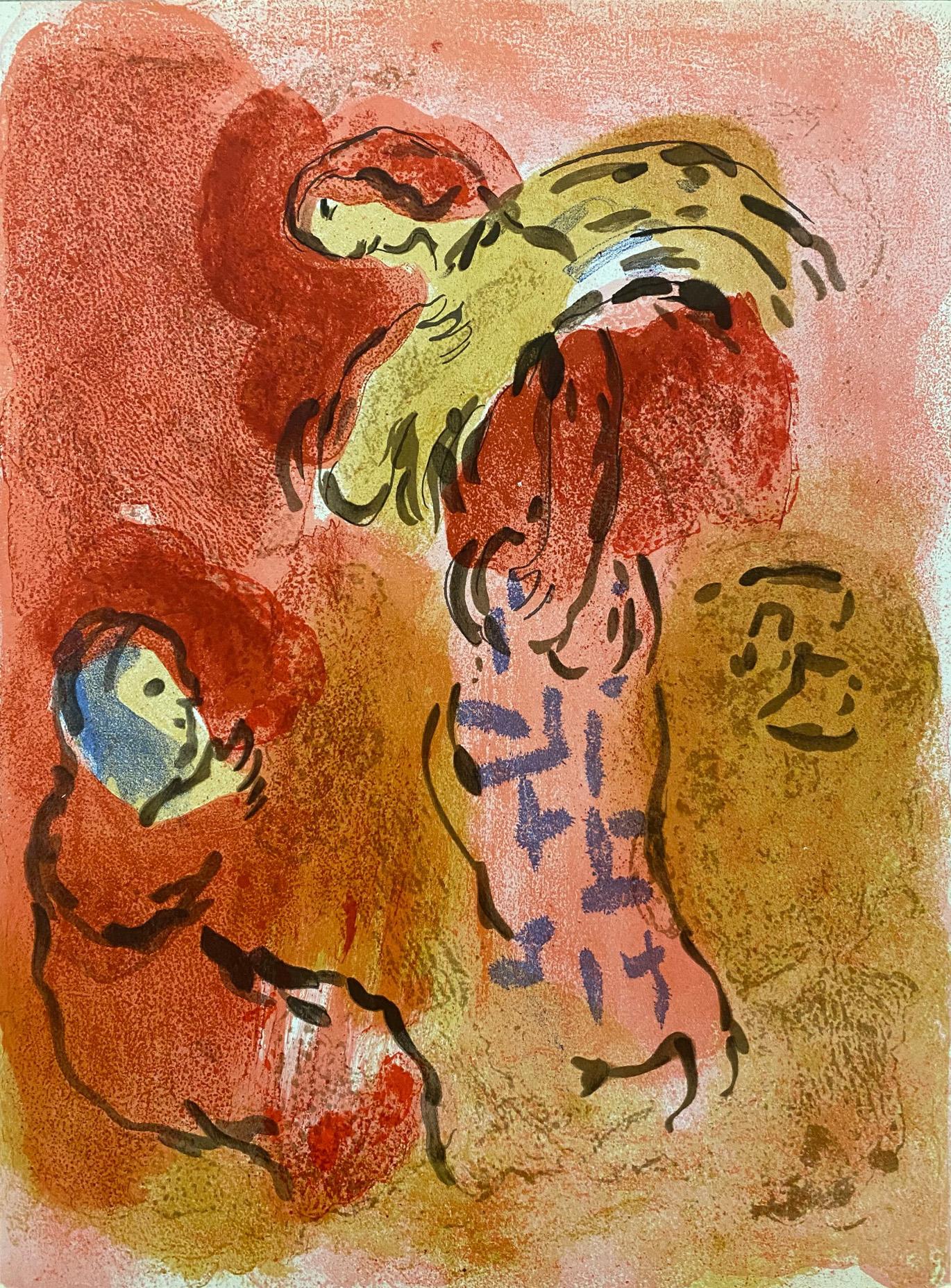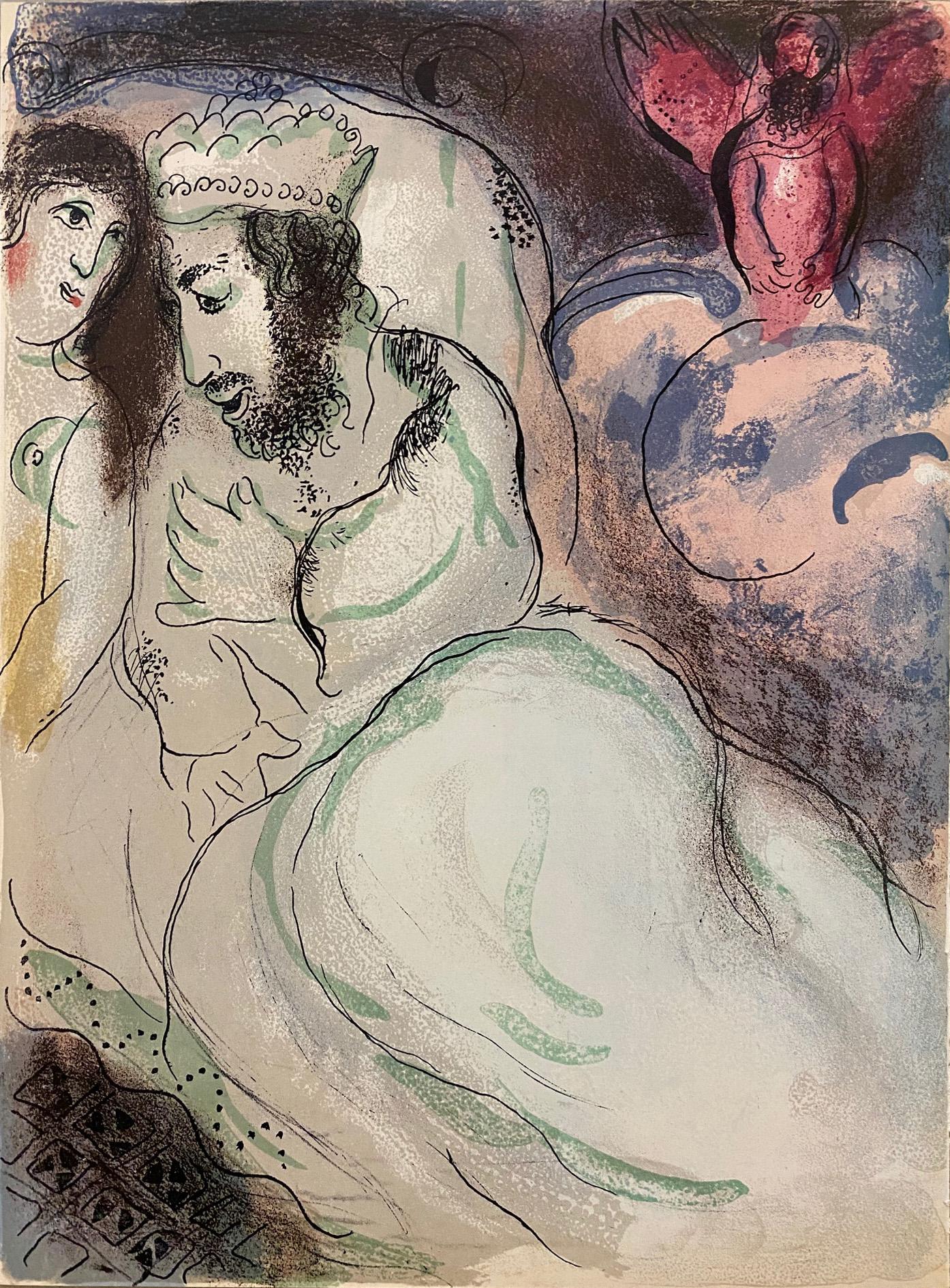Items Similar to Feminist Surrealist French Abstract Colorful Lithograph Print Myriam Bat Yosef
Want more images or videos?
Request additional images or videos from the seller
1 of 8
Myriam Bat YosefFeminist Surrealist French Abstract Colorful Lithograph Print Myriam Bat Yosef1971
1971
About the Item
Myriam Bat-Yosef
Surrealist abstract lithograph print in colorful abstract shapes and shades
Hand signed and dated 1971.
sheet measures 9.25 X 9.25 inches
The envelope and the Peter Buch poster is just for provenance and is not included in this sale.
Myriam Bat-Yosef, whose real name is Marion Hellerman, born on January 31, 1931 in Berlin, Germany to a Jewish family from Lithuania, she is an Israeli-Icelandic artist who paints on papers, paintings, fabrics, objects and human beings for performances. Myriam Bat-Yosef currently lives and works in Paris. In 1933, her family fleeing the Nazi Holocaust, Miriam Bat-Yosef emigrates to Palestine and settles in Jaffa. In 1936, she suffers a family tragedy, her father, militant Zionist, is called to fight, still recovering from an operation of appendicitis. The incision will become infected, antibiotics did not exist yet, and her father will die in the hospital after 9 months of suffering.
Myriam and her mother leave Palestine to live in Paris for three years. French is Myriam's first school language. In 1939, still fleeing Nazism, she returned to Palestine, leaving France by the last boat from Marseille. She moved to Tel Aviv with her mother, aunt and maternal grandmother.
In 1940, she began attending the Academy of Fine Arts in Tel Aviv and took her name as an artist, Bat-Yosef, which means Joseph's daughter in Hebrew, as a tribute to her father. In 1946, Myriam graduated as a kindergarten teacher but wanted to be an artist. Her mother enrolled her in an evening school to prepare a diploma of art teacher. At 19, she performs two years of military service in Israel.
In 1952, with a pension of $50 a month that her mother allocated, she went to study at the Beaux-Arts in Paris. To survive, she has several activities while studying. In 1955, she had her first solo exhibition, at the Israeli Club on Wagram Avenue in Paris. Many artists, such as Yaacov Agam, Yehuda Neiman Avigdor Arikha, Raffi Kaiser, Dani Karavan and sculptors Achiam and Shlomo Selinger attended the opening .
In 1956, she enrolled at the School of Fine Arts in Florence. This is where she meets the painter Errô. They share an icy studio in winter. Myriam moves to Milan with friends. She organizes a joint exhibition with Erro, one room each, at the Montenapoleone gallery. Her works are admired by the sculptor Marino Marini and the painters Renato Birolli and Enrico Prampolini. Myriam and Erro exhibit in Rome, Milan, Florence and meet many personalities: Alain Jouffroy and his wife, the painter Manina, Roberto Matta and his wife Malitte, textile artist who was one of the founders of the Pompidou Center. Back in Paris, Myriam and Erro get married, which allows Myriam to avoid being called into the Israeli army during the Suez Canal War.
In 1957, Myriam and her husband went to Iceland. Myriam works in a chocolate factory. Having enough money, she starts producing art again. She exhibited in Reykjavik's first art gallery. She meets the artist Sigridur Bjornsdottir, married to the Swiss painter Dieter Roth .
In 1958, Myriam and her husband leave for Israel. They exhibit in Germany, then in Israel. Back in Paris, the couple became friends with artists of the surrealist movement, such as Victor Brauner, Hans Bellmer, the sculptor Philippe Hiquily, Liliane Lijn, future wife of Takis and photographer Nathalie Waag. Erro and Myriam have a daughter on March 15, 1960, named Tura, after the painter Cosmè Tura, but also close to the Icelandic Thora or the Hebrew Torah. Bat-Yosef’s complex trajectory throughout the 20th century is linked as much to the transnational history of what was for a time called the School of Paris as it is to a certain legacy of Surrealism. Her work features the same idea of resolving antinomies that also defined the spirit of surrealism, and is enhanced with her readings of the Kabbalah and her spiritual grounding in Taoism. However, while there are reasons for her approach to be associated with the process of the ready-made, it is important to consider the immediate intrication of these works with her practice of performance, during which the body itself is also painted – a feminist response to Yves Klein’s Anthropometries (1960) and an echo of the happenings which Jean-Jacques Lebel organised at the time in Paris.
In 1963, Erró told Myriam that if she wants to be a painter, she can not be his wife. Myriam chose to be a painter and the couple divorced in 1964. Since that time, Myriam Bat-Yosef has exhibited in many countries: Europe, United States, Japan, etc.
Although long in the shadows, the work of Myriam Bat-Yosef has been greeted by many artists and personalities: Anaïs Nin, Nancy Huston, André Pieyre of Mandiargues, José Pierre, René de Solier , Jacques Lacarrière, Alain Bosquet, Pierre Restany, Sarane Alexandrian and Surrealist André Breton who, after a visit to her studio, confided to having been intrigued by its phantasmagorical dimension. She was included in the book Pop Art and Beyond: Gender, Race, and Class in the Global Sixties by Mona Hadler and Kalliopi Minioudaki. Extract "World Citizen, Artist of the Pop Era Sarah Wilson; Why do we know so little of Myriam Bat-Yosef, the most important female Israeli artist of the Pop era? Issues of identity and sexuality feature constantly in her work. She exhibited internationally from Reykjavik to Tokyo; she had two shows at Arturo Schwarz’s famous Dada/surrealist gallery in Milan; she participated in feminist art events in Los Angeles. Above all, in 1971, she conceived Total Art, a Pop Gesamtkunstwerk inside and outside the Israel Museum, Jerusalem. Painter, performer, and installation artist, she was also a lover, wife, and mother. Of Lithuanian-Jewish descent, she was close to the family of philosopher Emmanuel Levinas. An émigré in Paris she would repudiate a national passport, participating in Garry Davis’s short-lived “World Citizens” movement. She continues the lineage of women surrealist artists: Valentine Hugo, Leonor Fini, Dorothea Tanning, Leonora Carrington, Unica Zürn, Jane Graverol, Toyen, Alice Rahon and Frida Kahlo.
Bat-Yosef’s complex trajectory throughout the 20th century is linked as much to the transnational history of what was for a time called the School of Paris as it is to a certain legacy of Surrealism. While the artist never formally took part in the activities of André Breton’s group, which assigned women a primarily passive role by denying them any capacity for action and any inscription in the canon1, her work features the same idea of resolving antinomies that also defined the spirit of surrealism2, and is enhanced with her readings of the Kabbalah and her spiritual grounding in Taoism.
Such is the supposed opposition of art and life, which Bat-Yosef worked to make obsolete as early as 1964 by covering everyday objects in paint, late examples of which (1984-1993) can be seen in the exhibit. However, while there are reasons for her approach to be associated with the process of the ready-made3, it is important to consider the immediate intrication of these works with her practice of performance, during which the body itself is also painted – a feminist response to Yves Klein’s Anthropometries (1960) and an echo of the happenings which Jean-Jacques Lebel organised at the time in Paris, and which are not particularly noted for their emancipation of the female body4. The transition from one issue to the other is expressed through the use of a television set showing pictures of a performance next to another of her painted objects, La Tour des prières (The Tower of Prayers, 1977). Beside the object is a photograph that documents its activation through action, the presence of which prompts an additional question about its status, while its existence as an image in her works on paper informs us of its importance within the body of representations specific to the artist.
1987 - 1989 Parsons School of Design, Paris
1986 - 1989 French Institute of Fashion, Paris
1989 - 1990 WICE (Institute for Continuous Education), Paris
1986 - On request, in his workshop, and elsewhere.
Main personal exhibitions
Since 1958, Myriam Bat-Yosef has held more than 100 solo exhibitions worldwide including the main ones:
1958 Museum of Tel Aviv
1963 Reykjavik National Museum, Iceland
1964 Lucien Durand Gallery, Paris, France. Schwarz Gallery, Milan , Italy.
1965 Sydow Gallery, Frankfurt , Germany, presented by Alain Jouffroy.
1967 Aoki Gallery, Tokyo , Japan.
1969 Museum of Tel Aviv, Israel. Passepartout Gallery, Copenhagen , Denmark.
Latina Gallery, Stockholm, Sweden. Presented by Pierre Restany.
Schwarz Gallery, Milan, Italy. Presented by Franco Passoni
1970 Galerie Gmurzynska, Cologne , Germany, Presented by Pierre Restany.
1971 Israel Museum, Jerusalem , Israel. Noraena Hus Museum, Reykjavik
1995 Akureyri Museum, Iceland.
2005 Claude Samuel Gallery
2009 Claire Corcia Gallery, Paris
Main group exhibitions
1955, Salon of the Young Painting, Paris
1964, Tokyo Triennale, Japan.
1965 May Salon, Paris. Biennial of Paris
Museum of Modern Art in Rhode Island , United States
1967, Collage 67, Munich , Germany
1968, May Fair, Paris.
1972, Grafik Biennial. Vienna (Austria)
1976, World surrealist exhibition, Chicago . Organized by Franklin Rosemont
1986, Bellay Gallery, Paris; The Girls of Demeter , presented by Jacques Lacarrière.
1990, Artcurial, The Belvedere of Mandiargue, Paris
1998, Museum of Eroticism, Paris.
2001, Arturo Schwarz Collection, Israel Museum, Jerusalem
2002, Royal Academy of Arts; Paris Capital of the Arts 1900-1968, London, curator Sarah Wilson
2009, AREA, review (s) Femini Pluriel
Performances
1965 Biennial of Paris and the ORTF With François Dufrêne and Teresa Trujilo
Bilboquet Theater, with Copi, Martine Barat, Théo Lesoualch, directed by Jorge Lavelli
1981, Transmutation , by Catherine Dreyfus and Franco Contini, Paris. 22 minutes
1982, Corp Accord , with Eugénie Kuffler , Donguy Gallery, Paris
1991, Un Certain Plume , super 8 movie, of this performance, transferred to video, translated from Hebrew into French, said by Monique Rabanit. 60 minutes.
1991, Eryximaque ", created from slides, made by Myriam Bat-Yosef in 1965, with François Dufrêne and Teresa Trujilo. 8 minutes.
1992, My Testament , My Last Will , filmed in the exhibition at the Ramat-Gan Museum, by Honi Hameagel, original music by Dror Elimelech. 45 minutes.
- Creator:Myriam Bat Yosef (1931)
- Creation Year:1971
- Dimensions:Height: 9.25 in (23.5 cm)Width: 9.25 in (23.5 cm)
- Medium:
- Movement & Style:
- Period:
- Condition:good. minor wear commensurate with age. please see photos.
- Gallery Location:Surfside, FL
- Reference Number:1stDibs: LU38211853032
About the Seller
4.9
Platinum Seller
These expertly vetted sellers are 1stDibs' most experienced sellers and are rated highest by our customers.
Established in 1995
1stDibs seller since 2014
Typical response time: 1 hour
- ShippingRetrieving quote...Ships From: Surfside, FL
- Return PolicyA return for this item may be initiated within 3 days of delivery.
More From This SellerView All
- French Abstract Surrealist Color Lithograph Andre MassonBy André MassonLocated in Surfside, FLPublished Benincasa Carmine. Edizioni SEAT, Torino, Italy. Offset directly from the original plates. Limited edition. This is not hand signed or numbered. Signature in the printing p...Category
20th Century Surrealist Abstract Prints
MaterialsLithograph, Offset
- Feminist Surrealist French Abstract Colorful Lithograph Print Myriam Bat YosefLocated in Surfside, FLMyriam Bat-Yosef Surrealist abstract lithograph print in colorful abstract shapes and shades Hand signed and dated 1971. sheet measures 9.25 X 9.25 inches ...Category
1970s Surrealist Abstract Prints
MaterialsLithograph
- 1970s Modernist Swiss Colorful Surrealism Signed Dada Lithograph Andre ThomkinsBy André ThomkinsLocated in Surfside, FLThis one is titled "Walk in a Broken Lake" and depicts a surreal figure of a robed woman walking in an abstract landscape in yellow, green, red and blue with a Salvador Dali esque quality about it. Published by Edition Hansjörg Mayer, Stuttgart They published concrete poetry and art books by Mark Boyle, Richard Hamilton, Dorothy Iannone, John Latham, Tom Phillips, Dieter Roth, André Thompkins and Emmett Williams, to name just a few. André Thomkins (1930 - 1985) was a Swiss painter, illustrator, and poet. He attended art-school, taught by Max von Moos, 1947 – 1949 and the Académie de la Grande Chaumière, Paris, France, 1950. From 1952, he lived in Germany and taught at the Kunstakademie Düsseldorf between 1971 and 1973. Thomkins painted and drew ironic and fantastic pictures influenced by surrealism and dadaism. Together with Dieter Roth and Daniel Spoerri he prepared works of Eat Art. He also was a writer of palindromes. His friends and collaborators included Daniel Spoerri, Dieter Roth, George Brecht, Richard Hamilton and Karl Gerstner, Thomkins gained a reputation as an ‘artist’s artist’, and is considered one of the most important Swiss artists of the second half of the twentieth century.He died in 1985. His work is currently represented by Hauser & Wirth Zurich, Switzerland. Select group exhibitions: 2018 Kunsthalle Krems, 'Pablo Picasso. Arshile Gorky, Andy Warhol. Sculptures and Works on Paper. Hubert Looser Collection', Krems, Austria 2017 Kunsthandel Wolfgang Werner, 'Martin Barré, Karl Otto Götz, Ernst Wilhelm Nay, André Thomkins', Berlin, Germany 2013 Fabian & Claude Walter Galerie, 'Schweizer Avantgarde Kunst nach 1940', Zurich, Switzerland 2009 The Modern Institute, 'Thomas Houseago, Dieter Roth, Andre Thomkins', Glasgow, England Museum of Modern Art, 'Compass in Hand: Selections from the Judith Rothschild Collection', NYC 2004 Kunsthandel Wolfgang Werner, 'Arman, Baumeister, Götz, Graubner, Tàpies, Thomkins', Berlin, Germany 1994 Kunstmuseum Solothurn, 'Eine Schenkung. Grafik von Eduardo Chillida, Antoni Tàpies, Alexander Calder, Jean Dubuffet, Ben Nicholson, Giacometti, Tinguely, Thomkins', Solothurn, Switzerland 1992 Galerie Littmann, Tinguely zu Ehren. A Tribute to Jean Tinguely. Hommage à Tinguely, Basel, 1988 Museum Ludwig, 'Uebrigens sterben immer die anderen. Marcel Duchamp und die Avantgarde seit 1950', Cologne, Germany 1987 Aargauer Kunsthaus, 'Otto Grimm. Marc-Antoine Fehr. Christoph Gredinger', Aarau, Switzerland Cercle Municipal, 'Art contemporain suisse. Collection de la Banque du Gothard', Luxembourg, 1985 Centre national d'art et de culture Georges Pompidou, 'Livres d'artistes', Paris, France Rathaus, 'Claude Sandoz – Hans Schärer...Category
1970s Surrealist Figurative Prints
MaterialsLithograph, Offset
- 1970s Modernist Swiss Colorful Surrealism Signed Dada Lithograph Andre ThomkinsBy André ThomkinsLocated in Surfside, FLThis one is titled "Halemaid" and depicts a surreal figure of a robed woman in yellow red and blue with a Salvador Dali esque quality about it. Published by Edition Hansjörg Mayer, Stuttgart They published concrete poetry and art books by Mark Boyle, Richard Hamilton, Dorothy Iannone, John Latham, Tom Phillips, Dieter Roth, André Thompkins and Emmett Williams, to name just a few. André Thomkins (1930 - 1985) was a Swiss painter, illustrator, and poet. He attended art-school, taught by Max von Moos, 1947 – 1949 and the Académie de la Grande Chaumière, Paris, France, 1950. From 1952, he lived in Germany and taught at the Kunstakademie Düsseldorf between 1971 and 1973. Thomkins painted and drew ironic and fantastic pictures influenced by surrealism and dadaism. Together with Dieter Roth and Daniel Spoerri he prepared works of Eat Art. He also was a writer of palindromes. His friends and collaborators included Daniel Spoerri, Dieter Roth, George Brecht, Richard Hamilton and Karl Gerstner, Thomkins gained a reputation as an ‘artist’s artist’, and is considered one of the most important Swiss artists of the second half of the twentieth century.He died in 1985. His work is currently represented by Hauser & Wirth Zurich, Switzerland. Select group exhibitions: 2018 Kunsthalle Krems, 'Pablo Picasso. Arshile Gorky, Andy Warhol. Sculptures and Works on Paper. Hubert Looser Collection', Krems, Austria 2017 Kunsthandel Wolfgang Werner, 'Martin Barré, Karl Otto Götz, Ernst Wilhelm Nay, André Thomkins', Berlin, Germany 2013 Fabian & Claude Walter Galerie, 'Schweizer Avantgarde Kunst nach 1940', Zurich, Switzerland 2009 The Modern Institute, 'Thomas Houseago, Dieter Roth, Andre Thomkins', Glasgow, England Museum of Modern Art, 'Compass in Hand: Selections from the Judith Rothschild Collection', NYC 2004 Kunsthandel Wolfgang Werner, 'Arman, Baumeister, Götz, Graubner, Tàpies, Thomkins', Berlin, Germany 1994 Kunstmuseum Solothurn, 'Eine Schenkung. Grafik von Eduardo Chillida, Antoni Tàpies, Alexander Calder, Jean Dubuffet, Ben Nicholson, Giacometti, Tinguely, Thomkins', Solothurn, Switzerland 1992 Galerie Littmann, Tinguely zu Ehren. A Tribute to Jean Tinguely. Hommage à Tinguely, Basel, 1988 Museum Ludwig, 'Uebrigens sterben immer die anderen. Marcel Duchamp und die Avantgarde seit 1950', Cologne, Germany 1987 Aargauer Kunsthaus, 'Otto Grimm. Marc-Antoine Fehr. Christoph Gredinger', Aarau, Switzerland Cercle Municipal, 'Art contemporain suisse. Collection de la Banque du Gothard', Luxembourg, 1985 Centre national d'art et de culture Georges Pompidou, 'Livres d'artistes', Paris, France Rathaus, 'Claude Sandoz – Hans Schärer...Category
1970s Surrealist Figurative Prints
MaterialsLithograph, Offset
- Lithograph Belgian American Surrealism WPA Modernist Karl Fortess Surrealist ArtLocated in Surfside, FLKarl Eugene Fortess (1907-1993) Original color lithographs on BFK Rives paper, 1966, Hand signed and numbered 29/36 in pencil, Sheet size 20.5 x 15 inches. Karl E. Fortess (1907-1993) was a painter, printmaker and teacher, of Boston, Massachusetts and Woodstock, N.Y. Fortess was born in Antwerp, Belgium on October 13, 1907, and became an American citizen in 1923. He studied at the Art Institute of Chicago, the Art Students League in New York, and the Woodstock School of Painting with Yasuo Kuniyoshi. In 1937 the Works Progress Administration sent him and several other artists to Alaska to document the towns, villages, and remote wilderness landscapes (Pemberton, “Alaska art museum collects WPA’s Depression works from the territory,” Columbia Daily Tribune, November 9, 2003). Trains, trucks, and industrial buildings were what Karl Fortess envisioned when the Public Works of Art Project suggested that he depict “the American Scene.” His work bears the influence of Surrealism, Russsian Constructivist art and Cubism. He was part of a circle of left leaning artists loosley involved with the WPA which included Sol Wilson, Isaac Soyer, Louis Lozowick, Abraham Harriton, Ben Shahn, William Gropper, Nahum Tschacbasov, Morris Shulman, Yasuo Kuniyoshi, Louis Slobodkin, Adolf Dehn, Le Corbusier and Louis Schanker. Karl Fortress taught at the Art Students League, Brooklyn Museum Art School, Louisiana State University, Fort Wright College, and Boston University School of Fine and Applied Arts. He was a member of the Artists Equity Association, Society of American Graphic Artists, American Association of University Professors, and the British Film Institute. He was awarded the Guggenheim Fellowship in 1946, was named an Associate of the National Academy of Design in 1960 and elected to full Academician in 1971. Fortess taught at many different schools, including Boston University School of Fine Art, where he also created an archive of interviews with more than two hundred and fifty contemporary American painters, sculptors, and graphic artists including many with with artists associated with the Woodstock, N.Y. art community. Among the interviewees are Kenneth Armitage, Will Barnet, Romare Bearden, George Biddle, James Brooks, Adolph Dehn, Jane Freilicher, Julian Levi, Alice Neel, Larry Rivers, Moses Soyer, Dorothy Varian...Category
Mid-20th Century Surrealist Landscape Prints
MaterialsLithograph
- French Abstract Surrealist Color Lithograph Andre MassonBy André MassonLocated in Surfside, FLPublished Benincasa Carmine. Edizioni SEAT, Torino, Italy. Offset directly from the original plates. Limited edition. This is not hand signed or numbered. Signature in the printing plate. Size is of the full sheet. André-Aimé-René Masson (4 January 1896 – 28 October 1987) was a French artist. Masson was born in Balagny-sur-Thérain, Oise, but when he was eight his father's work took the family first briefly to Lille and then to Brussels. He began his study of art at the age of eleven at the Académie Royale des Beaux-Arts in Brussels, under the guidance of Constant Montald, and later he studied in Paris. He fought for France during World War I and was seriously injured. His early works display an interest in cubism. He later became associated with surrealism, and he was one of the most enthusiastic employers of automatic drawing, making a number of automatic works in pen and ink. Masson would often force himself to work under strict conditions, for example, after long periods of time without food or sleep, or under the influence of drugs. He believed forcing himself into a reduced state of consciousness would help his art be free from rational control, and hence get closer to the workings of his subconscious mind. Masson experimented with altered states of consciousness with artists such as Antonin Artaud, Michel Leiris, Joan Miro, Georges Bataille, Jean Dubuffet, and Georges Malkine, who were neighbors of his studio in Paris. From around 1926 he experimented by throwing sand and glue onto canvas and making oil paintings based around the shapes that formed. By the end of the 1920s, however, he was finding automatic drawing rather restricting, and he left the surrealist movement and turned instead to a more structured style, often producing works with a violent or erotic theme, and making a number of paintings in reaction to the Spanish Civil War (he associated once more with the surrealists at the end of the 1930s). Under the German occupation of France during World War II, his work was condemned by the Nazis as degenerate. With the assistance of Varian Fry in Marseille, Masson escaped the Nazi regime on a ship to the French island of Martinique from where he went on to the United States. Upon arrival in New York City, U.S. customs officials inspecting Masson's luggage found a cache of his erotic drawings. Denouncing them as pornographic, they ripped them up before the artist's eyes. Living in New Preston, Connecticut his work became an important influence on American abstract expressionists, In particular Arshile Gorky drew on it, as did Jackson Pollock and Mark Rothko. Following the war, he returned to France and settled in Aix-en-Provence where he painted a number of landscapes. Masson drew the cover of the first issue of Georges Bataille's review, Acéphale, in 1936, and participated in all its issues until 1939. His brother-in-law, the psychoanalyst Jacques Lacan...Category
20th Century Surrealist Abstract Prints
MaterialsLithograph, Offset
You May Also Like
- Abstract - Surrealist LithographLocated in Houston, TXSurreal lithograph with light lavender and blue colors, 1982. Titled and numbered on lower left and signed lower right in pencil. Displayed on a white mat with a gold border and fi...Category
1980s Surrealist Abstract Prints
MaterialsPaper, Lithograph
- Noémi et ses belles-fillesBy Marc ChagallLocated in Paris, FROriginal lithograph by Marc Chagall from The Bible of 1960 Noémi et ses belles-filles Unsigned 35 x 26 cm Excellent conditionCategory
1960s Surrealist Abstract Prints
MaterialsLithograph
- Ruth aux pieds de BoozBy Marc ChagallLocated in Paris, FROriginal lithograph by Marc Chagall from The Bible of 1960 Ruth aux pieds de Booz Unsigned 35 x 26 cm Excellent conditionCategory
1960s Surrealist Abstract Prints
MaterialsLithograph
- Tamar belle-fille de JudaBy Marc ChagallLocated in Paris, FROriginal lithograph by Marc Chagall from The Bible of 1960 Tamar belle-fille de Juda Unsigned 35 x 26 cm Excellent conditionCategory
1960s Surrealist Abstract Prints
MaterialsLithograph
- Ruth glaneuseBy Marc ChagallLocated in Paris, FROriginal lithograph by Marc Chagall from The Bible of 1960 Ruth glaneuse Unsigned 35 x 26 cm Excellent conditionCategory
1960s Surrealist Abstract Prints
MaterialsLithograph
- Sara et AbimelecBy Marc ChagallLocated in Paris, FROriginal lithograph by Marc Chagall from The Bible of 1960 Sara et Abimelec Unsigned 35 x 26 cm Excellent conditionCategory
1960s Surrealist Abstract Prints
MaterialsLithograph
Recently Viewed
View AllMore Ways To Browse
French Fashion Prints
Retro Print Fabric
French Print Fabric
Bat Used
Vintage Fabric Prints Designs
Bates And Bates
Money Print
Set Of Multiple Prints French
Colorful Lithograph
Vintage Boat Prints
Vintage French Print Fabric
Vintage French Military
French 50s Art
German Surrealist
1940s French Prints
Dior 1971
Pop Art Lithographs 1960s
The Paris Review Print




